13th October 2010
![]()
14th October 2010
Cycled 14km around the city.
Spent the morning fixing problems with the website. When I started it was sunny! When I finished the clouds had rolled overhead... Jumped on the bike and headed into the city for some exploration.
Found the Reichstag (but no sign of Marinus van der Lubbe :-) and a really interesting memorial. It is dedicated to the 96 members of the German government killed (mostly in Concentration Camps) murdered by the National Socialist Party after they rose to power in 1933. On each slab there is the name of the opposition politician killed, and the KZ (Konzentrationslager) where they died.
After that i visited the Memorial to the Murdered Jews of Europe - 2711 stone slabs of different heights spread over a whole city block. I really don't know what to make of it? The Jewish were certainly not the only group of people persecuted by the Nazi party, and a memorial of this size should (in my opinion) have been dedicated to all of those different groups of people. What about the gypsies, homosexuals, political opponents, mentally and physically disabled people, T-4 euthanasia victims, catholic priests, Slavic people, Russian prisoners of war, ethnic polish etc... 16,900,000 in total, not just 6 million Jewish. Apparently there is one to the homosexual victims of the holocaust somewhere across the road, so tomorrow I will go and have a look for that.
The museum underneath was good, and did occasionally mention the Roma and Sinti Gypsies. Each room had a fairly unique and different perspective - from basic history of the persecution of the Jewish people in Germany, to extracts from victims themselves - often from diaries found on the bodies of victims after they were exhumed.
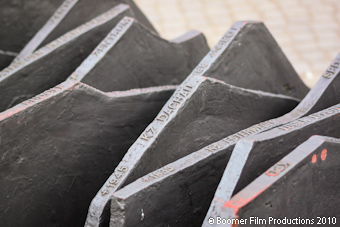
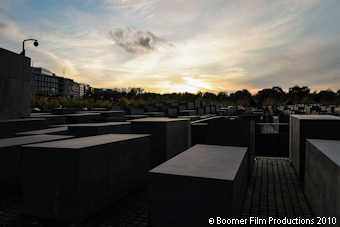
![]()
15th October 2010
Day 3 - Berlin
Spent all the morning searching for a new coat, as my one I had been using was useless in cold weather. A cheap snowboarding/ski jacket - waterproof and really warm - should help me out on my journey.
Had a little walk around the area around the Brandenburg Gate, and found the memorial to the homosexuals persecuted by the National Socialist Party. It was a rather strangely shaped slopping box, just across the road from the Jewish memorial I saw yesterday. Inside the box and viewable through a small window - a video was playing, showing two young men kissing on the exact spot as the memorial is, and at the same angle as you are viewing the video. After that I went back to take more photos and film of the Jewish memorial, just as the sun was going down.
I finally got the video editing software to work on my netbook... HD video has very large file sizes. I am filming at 1280x720 and that still gives me over 200mb per minute! I can now at least convert the files to a smaller size to check through them, but still staying with HD quality, just using a smaller 720x480 file size and converting to an avi... I'm gonna have to be ruthless and throw away stuff I think I'm not going to be able to use.
Had a nice quiet night in and watched a great documentary given to me by Claudia - "Collapse", about a former policeman turned investigative reporter Michael Ruppert.


![]()
16th October 2010
Day 4 - Berlin
Today I spent the morning map hunting! Apparently its 4 maps just to get me from Berlin to the Dutch border... This will cost me a fortune by the end of the trip - maybe it would have been easier just to have bought a sat nav? I have GPS on my second phone but haven't got around to figuring out exactly how it works. At least from Monday I have good quality maps which even show bicycle paths.
I spent my afternoon trying to avoid the rain in the excellent museum the Topologie Of Terror. An extremely well thought and laid out exhibition on the site of the former Gestapo Head Quarters, and right in the middle of the old Nazi administration district. The museum took the history right through the full history of the SS, SA, SD, Gestapo, etc... and in a way that is well represented and shows all the perspectives. The displays are mostly based on photographs, newspaper articles from the time and actual Nazi documentation. There is a display board for just about every type of person oppressed under the 3rd Reich, with equal emphasis on the Gypsies, Homosexuals, Political Prisoners, Jewish etc. The last part is reserved for how German is dealing with its past, and the capture and prosecution of Nazi war criminals.
As well as the indoor museum there was a long exhibition that runs outside alongside an original remaining part of the Berlin Wall. An extremely good museum that I would highly recommend.


![]()
17th October 2010
Day 5 - Berlin
Started the day with a trip to the Schöneweide Arbeitslager, just south of the city. Spread amongst 7 of the original 13 barracks is a museum - unfortunately for me only in German - this Arbeitslager (forced labour camp) originally housed 2000 mostly Italian prisoners who would work in nearby factories, and also within the camp in a workshop that made vaccines.
The strangest thing about Schöneweide is that the museum only has 7 Barracks out of the 13 originals, but the most of the others still exist. By the time this site only opened as a memorial in the mid 1990's some of the Barracks had already been sold to local businessman. One is a sauna(!), one is a mechanics garage, one appears to be a kindergarten, and one is owned by BMW - which made it impossible not to think of Allach just outside of Dachau... The 6 that the site doesn't own are right in the middle, separated by a fence. Barrack 13 is about 200 metres past all the other buildings and perched on the far corner of the site. I would have liked to have looked inside Barrack 13 as the inside is a good period reconstruction of an original barrack, but they don't open that until 2pm, and I had to run!
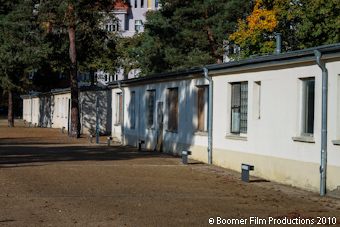

After crossing most of the city on the S-Bahn and a 20 minute walk from the station, I arrived at a memorial site to one of the most important former Concentration Camps within the National Socialist system, the Sachsenhausen Gedenkstätte. The first impression I had was of the size - its enormous! It feels much larger than Dachau, and strangely the barracks were arranged in a very un-nazi like half semi-circle.
My other impression of Sachsenhausen is that it is one of the best memorial sites I have seen. The museums - many of them scattered all over the site - are fantastic. They deal with the sites history in a good and honest way, from its initial construction in 1936 to how the Russians liberated it, and then used it for many years to house their own prisoners...
The gas chambers and crematoria on the site were not destroyed by the retreating Nazi's, but in fact destroyed by the Communists in the early 1950's. Unfortunately this sort of thing happened a lot at the sites in East Germany, as the Russians were not really interested in preserving the past - unless they could of course get any propaganda victory from doing so. One of the most shocking parts of the site for me was the mortuary. The sheer size of it illustrated the amount of death at Sachsenhausen.
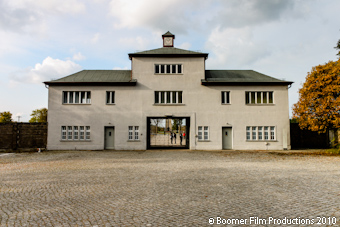
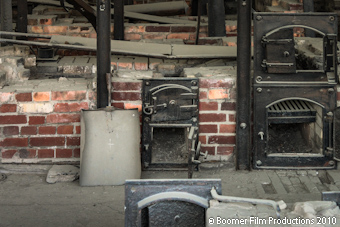
![]()
18th October 2010
Day 6 - Berlin to Fürstenburg 100km
Its the first day of proper cycling! After starting off at a respectable 9am it took over an hour to get out of the city itself. I cycled north through many sleepy towns and villages - some were so deserted I didn't see one person - and finally after about 3 hours I joined up with the Berlin-Kopenhagen Radweg. This cycle path runs over 600km from Berlin all the way up to Copenhagen in Denmark. The cycle path for most parts runs on roads not open to cars, which is great for me as then I can put headphones on and cycle with music, but also included a beautiful 10km riding beside a canal.
The biggest problem was not my legs, but keeping my body at a good temperature. In the sunlight it was fairly warm, but in the shade it was bitterly cold. It took a lot of experimentation of coat/jumper/T-shirts to get it right.
Taking back roads through a forest not so far from Fürstenburg, and a few kilometres from the Ravensbrück Memorial Site, I had quite a shocking experience. I came across a sign which stated I was on the corner of the former Uckermark KZ, an enormous Concentration Camp which existed from 1942-1945, a Camp for children, for Girls in fact. I simply was not expecting this and had no idea it was here... There are signs indicating that something is still hidden in the forest there, so for this reason I've made the decision to stay here in Fürstenberg for a whole day and therefore an extra night, so as well as visiting the Ravensbrück Gedenkstätte I can cycle back to the forest to see what is left of the camp for children...


![]()
19th October 2010
Day 7 - Fürstenburg
After a big breakfast in a slightly over-priced Pension (B&B) I cycled across to the reason why I'm in the middle of nowhere, the Ravensbrück Gedenkstätte.
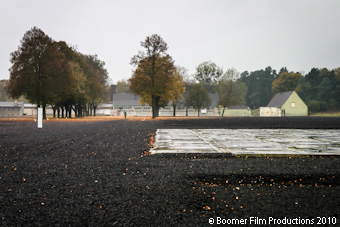

Ravensbrück opened up in 1939 and was liberated by the rapidly advancing Russians in 1945. It was the largest camp for women in the Reich, although there was a section added later for men. It stood on the opposite bank of a small lake from the town of Fürstenburg about 80km north of Berlin, and was a controlling camp, with authority and control over a large number of subsidiary camps in the area.
Although the camp was run officially by the SS, whom only men could serve with, the daily running of the camp and the responsibilty for the control of the female prisoners lay exclusively with female staff, auxiliary to the SS. The female "Matrons" ran the camp with an iron fist, and very little was needed to provoke a Matron to commit murder, torture, humiliation or severe punishment on the women she controlled. This is probably the most interesting (and distressing) part of the history of Ravensbrück - womens inhumanity to other women.
The museum (especially the one in the former SS housing) deals with the subject in a very interesting way. As well as having many exhibits focusing on the women who suffered there - who came from pretty much every country in Europe - there is one which deals specifically with the perpetrators themselves, the women who worked at Ravensbrück, the women who committed horrific crimes against other women. There was room after room of photographs and profiles of their lives, of how they came to work at the camp (some volunteered, and some were drafted) and if they were held accountable for their actions after the war. A few were sentenced to death, but many were never held responsible for the brutality and torture of the women at these camps. Many of the Matrons who were trained at Ravensbrück, got their first work experience there, and then were sent afterwards all over the Reich to run many of the female camps spread across Europe, even to Auschwitz to run the female camp at Birkenau.
Around 132,000 women and children, 20,000 men were registered as Ravensbrück prisoners between 1939 and 1945, as well as 1,000 young girls and young women (in the Uckermark camp next door). Tens of thousands were murdered, starved to death, died of disease or were killed as part of horrific medical experimentation.
Unfortunately most of the original buildings were destroyed by the Russians during their long occupation of the site. Like many of the other former concentration camps falling in East Germany they used it as a military base for many years, in fact from May 1945 until January 1994.
Just before I left the site I stood for a few moments by the edge of the lake and looked out over toward Fürstenburg (surely only 500 metres away) and wondered why upon the liberation of Ravensbrück most of the townspeople from Fürstenburg claimed they had no idea the camp was actually there. The only conclusion I could draw was that mankind is capable of some truly disgusting things - genocide and torture sprung to mind. However turning away and pretending such brutality and inhumanity doesn't exist - when its right under your own frickin nose! - is just as horrific. Its a wondrous world we live in...
![]()
20th October 2010
Day 8 - Fürstenburg to Wittstock 81km
Somehow I didn't get cycling until 9:30, but as I only had to cover about 70km (turned out to be a little more) I assumed that wouldn't be a problem. I clearly assumed wrong! Hill, after hill, after hill (why do they only seem to go up?) made travelling hard going. To make matters worse there was a fairly strong wind seemingly directed at only at me which slowed me down even further. After breaking through a few pain barriers along the way at about 3pm I arrived at the Todesmarches Gedenkstätte, about 12km north of Wittstock.
Before the Russians liberated the Sachsenhausen KZ the SS started to evacuate prisoners in "Death Marches". Forcing thousands of prisoners to walk in columns heading north-west, with only the sick and near-dead left behind. If a prisoner stopped for a moment to rest he would be shot. If they fell at any point they would be shot and the corpse left by the side of the road where the prisoner fell. I remember reading articles about the death marches from Dachau (all heading south to the Alps) and how the U.S. army were desperately trying to catch up with the marches, to liberate the prisoners from their SS guards. All they had to do was follow the roads lined with corpses and they knew they were heading in the right direction...
The Todesmarches Museum is in the middle of a forest in a village called Belower Wald. It was here that one of these death marches stopped for a few days. The museum (all outdoor) illustrates what the marches were like from the prisoners perspective. In the surrounding forest there are many little red triangles (the mark of a political prisoner on their uniforms) where evidence of the prisoners stay still remains. There were little carvings on the sides of trees, and some trees where the bark was stripped off - apparently the starving prisoners were trying to eat the bark. There was also a map showing the route the women of Ravensbrück had to make in their own death march.


The picture of the tree shows marks from the barbed wire (which was wrapped around them to form a fence) still on the bark after 65 years.
To this day nobody how many people dies on the death marches, as many bodies were simply buried in unmarked graves in local cemeteries after the end of the war.
Just to note some other death marches I have been reading recently about - "Trail of Tears" where Cherokee Indians had to march westward towards Oklahoma and thousands died along the way; The Japanese army in 1945 marching prisoners of war (over 10,000 dead); Brünn death march in 1945 when the Czechs began deporting all Sudentenland ethnic Germans to Austria after the end of the war; South Korean commanders in 1951 forcibly marched 200,000 of their own soldiers and up to 90,000 of them dies along the way...
![]()
21st October 2010
Day 9 - Wittstock to Dallmin 80km
A hard day... Just cycling, no memorials, no dark human history, just cycling. All day cycling into really strong headwinds. I wanted to get all the way to the town of Ludwigslust as it was bigger and I assumed there would be more hotels there. By 4pm though my will to go any further had long gone. I had just struggled too much and needed to rest. I saw an advert for a Pension about 6km away, phoned them and then cycled there. Turned out I get a mini apartment (!) for the night, with a massive bathroom, double bed and a small kitchen, and all for €20!
I hope tomorrow will be a little easier. I have decided to take a slightly longer route to Hamburg by travelling down to and then following the river Elbe, all the way up into Hamburg. I desperately need a change of scenery as all I have seen for days is sleepy (dead) villages, towns where nothing happens and everything seems to be closed, and hills riding into the wind. I figure as the river goes slowly downhill things should be slightly easier - well that is the idea...
Another problem about sleepy towns is none of them have internet cafe's so I can update this blog! I keep getting a backlog of a few days...
![]()
22nd October 2010
Day 10 - Dallmin to Hitzacker 81km
I had an earlier start today, getting on the road at 8:45am. It was raining lightly, bitterly cold and the wind was yet again a fight all the way. With some hard map studying I managed to find a short route to take me across a railway line, but when I got there the road was closed and it was impossible to cross the tracks (my map showed it was a railway crossing...) The resulting detour cost me around 1 hour extra cycling against the wind.
After struggling through many small villages and hamlets I finally got to the road that would take me down to the river Elbe, except that it went up most of the way... I finally arrived in the town of Lenzen at about 11:45 and stopped for a quick cup of tea and a sandwich (very British of me).
Continuing on down to the river it was quite a surprise to find no bridge across it! instead they have a little river boat big enough to take a few cars at a time across. Right by the river there was also a sign marking that this part of the river was the border between East and West Germany. There was an enormous guard tower to watch over the river which is now an observation post for the public to see far down the river. After paying my €1,50 I held onto my bike for dear life as we crossed to the other side.

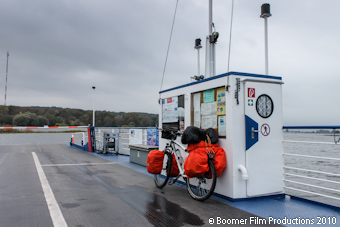
Finally on the road again! for 2 minutes... Then I had to climb a small mountain with the bike... I spent 20 minutes pushing the damn thing up this ridiculously steep hill through the middle of a forest before I could get going again. But after that, all I can say is "West Germany" is much easier to cycle! From then on it was cycle paths along the river (a bit windy) and cycle paths alongside roads going through forests (less windy).
I had hoped to get all the way to Blekede, but was so exhausted from the mornings wind battles that I decided to stop for the night in the town of Hitzacker. This weather is really getting me down. I would do anything for a little sunshine and a few minutes where the sky is blue and not grey and forboding.